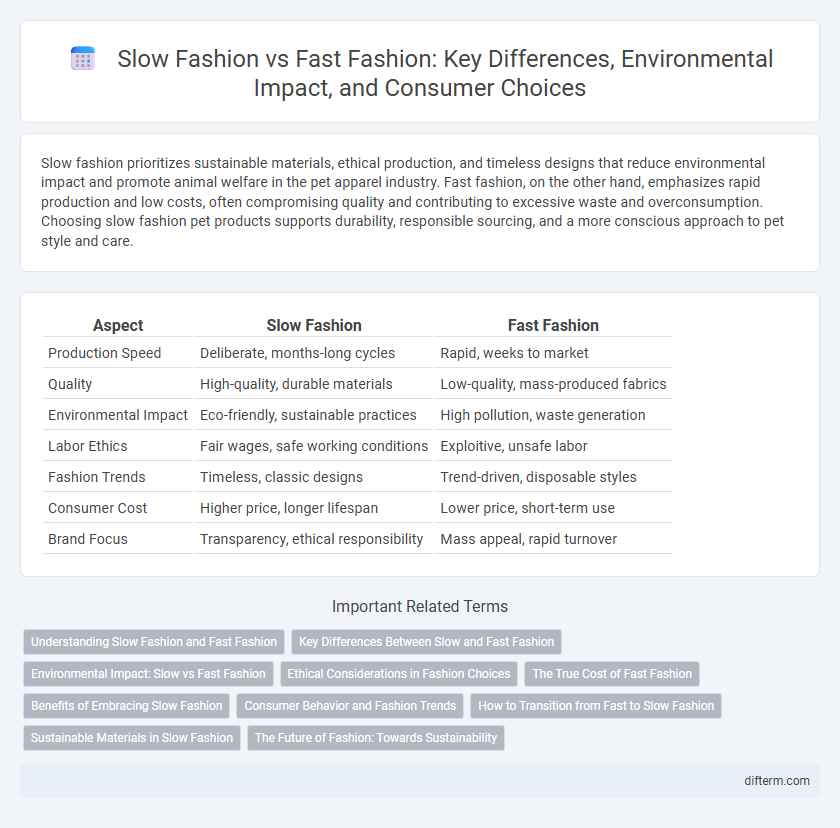Slow fashion prioritizes sustainable materials, ethical production, and timeless designs that reduce environmental impact and promote animal welfare in the pet apparel industry. Fast fashion, on the other hand, emphasizes rapid production and low costs, often compromising quality and contributing to excessive waste and overconsumption. Choosing slow fashion pet products supports durability, responsible sourcing, and a more conscious approach to pet style and care.
Table of Comparison
| Aspect | Slow Fashion | Fast Fashion |
|---|---|---|
| Production Speed | Deliberate, months-long cycles | Rapid, weeks to market |
| Quality | High-quality, durable materials | Low-quality, mass-produced fabrics |
| Environmental Impact | Eco-friendly, sustainable practices | High pollution, waste generation |
| Labor Ethics | Fair wages, safe working conditions | Exploitive, unsafe labor |
| Fashion Trends | Timeless, classic designs | Trend-driven, disposable styles |
| Consumer Cost | Higher price, longer lifespan | Lower price, short-term use |
| Brand Focus | Transparency, ethical responsibility | Mass appeal, rapid turnover |
Understanding Slow Fashion and Fast Fashion
Slow fashion emphasizes sustainable production, quality materials, and ethical labor practices, aiming to reduce environmental impact and promote durability. Fast fashion prioritizes rapid production, low costs, and constantly changing trends, often resulting in overconsumption and increased textile waste. Consumers seeking longevity and environmental responsibility tend to favor slow fashion over fast fashion's disposable model.
Key Differences Between Slow and Fast Fashion
Slow fashion emphasizes sustainable materials, ethical production, and timeless design, promoting durability and reduced environmental impact. Fast fashion prioritizes rapid trend replication, low costs, and mass production, often resulting in lower quality and higher waste. Key differences include supply chain transparency, product lifespan, and the social responsibility standards upheld by each approach.
Environmental Impact: Slow vs Fast Fashion
Slow fashion significantly reduces environmental impact by promoting sustainable materials, ethical production, and longer garment lifespans, minimizing textile waste and carbon emissions. Fast fashion mass-produces cheap clothing using non-renewable resources, leading to excessive water consumption, chemical pollution, and large volumes of landfill waste. Emphasizing slow fashion supports eco-friendly practices that conserve natural resources and reduce global fashion industry pollution.
Ethical Considerations in Fashion Choices
Slow fashion emphasizes ethical considerations by promoting fair labor practices, sustainable materials, and reduced environmental impact, contrasting with fast fashion's reliance on mass production that often exploits workers and depletes natural resources. Consumers choosing slow fashion support transparency and social responsibility, ensuring garment workers receive fair wages and safe conditions. Ethical fashion choices prioritize durability, quality, and eco-friendly processes, fostering a sustainable industry that values human rights and environmental stewardship.
The True Cost of Fast Fashion
Fast fashion accelerates production to meet constant consumer demand, leading to excessive textile waste and environmental degradation. The true cost of fast fashion includes exploitative labor practices, significant carbon emissions, and massive water consumption that harm ecosystems globally. By contrast, slow fashion emphasizes sustainable materials and ethical manufacturing, reducing the industry's ecological footprint and promoting fair labor standards.
Benefits of Embracing Slow Fashion
Embracing slow fashion reduces environmental impact by minimizing textile waste and lowering carbon emissions through sustainable production methods. It promotes ethical labor practices by supporting fair wages and safe working conditions in garment manufacturing. Consumers benefit from higher-quality, durable clothing that encourages mindful purchasing and long-term wardrobe investment.
Consumer Behavior and Fashion Trends
Consumer behavior in fashion increasingly favors slow fashion as awareness of environmental impact and ethical production rises, leading to a demand for sustainable materials and quality craftsmanship. Fast fashion trends drive rapid consumption and disposal patterns, encouraging impulse buying and frequent wardrobe updates based on ephemeral styles. This shift influences brands to balance trend responsiveness with sustainable practices to meet evolving consumer priorities.
How to Transition from Fast to Slow Fashion
Transitioning from fast fashion to slow fashion involves prioritizing quality over quantity by investing in timeless, durable pieces that reduce waste and promote sustainability. Consumers should research ethical brands, embrace secondhand shopping, and adopt mindful consumption habits that emphasize the environmental and social impact of their clothing choices. Incorporating capsule wardrobes and supporting local artisans further encourages a sustainable shift in personal fashion practices.
Sustainable Materials in Slow Fashion
Slow fashion prioritizes sustainable materials like organic cotton, bamboo, and recycled fibers, reducing environmental impact compared to synthetic fabrics common in fast fashion. These eco-friendly textiles require less water, produce fewer greenhouse gases, and support biodegradable waste cycles. Emphasizing quality over quantity, slow fashion brands invest in durable, sustainable materials that promote ethical production and long-term wardrobe value.
The Future of Fashion: Towards Sustainability
Slow fashion emphasizes durability, ethical production, and eco-friendly materials, fostering a sustainable industry that reduces waste and carbon emissions. Fast fashion's relentless demand for rapid trends leads to environmental degradation and exploitative labor practices. The future of fashion hinges on adopting circular economy principles, advancing sustainable textiles like organic cotton and recycled fabrics, and enhancing transparency in supply chains to achieve long-term ecological balance.
slow fashion vs fast fashion Infographic

 difterm.com
difterm.com